
Founded in 1916, Evergreen Slate Co., Inc. has recently seen a variety of developments, including the acquisition of a quarry site for Unfading Mottled Green-Purple slate.
Founded in 1916 by the Hicks family as a supplier of stone from the Vermont/New York slate belt, Evergreen Slate Co., Inc. of Granville, NY, has seen the industry rise and decline several times over the past 90 years. Today, with new ownership, a recent quarry acquisition and two new divisions, the company is poised to ensure that its fortunes are positive for decades to come.
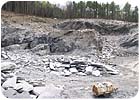
The center of the quarry reveals the “slant,†which contains the highest degree of workable material. Generally, these “slants†sit at a 45-degree angle within the quarry; however, the slant at the Unfading Mottled Green-Purple quarry sits at an angle of only 15 degrees, making it much easier to work.
Today, the company has 74 direct employees, and the Hicks family had owned the company for 90 years before finally selling the operation one and half years ago. Fred Whitridge now serves as President and Bob Jenks serves as Vice President, although Evergreen Slate still has a lot of experience on board, including Former Company President Clark Hicks, who is still involved in the company. Other primary employees include Sales Manager Jo Anne Baker, who has been with the company for 17 years; General Manager Chris Bean, who has been with the company for six years; and Production Manager Ray Loomis, who has been with the company for 20 years.
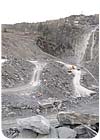
Another major quarrying site for Evergreen Slate is its Calder Quarry, which produces two colors - Unfading Green and Unfading Gray.
The new principal owners at Evergreen explained that they not only want to move the company forward, but also to promote the overall possibilities of slate as a design material. “When you look at all of the potential applications of slate - fireplaces, countertops, bathrooms or exterior solutions - that has so far been a small component of the slate industry,†Jenks explained. “It is natural that we would be the people to supply these products to the marketplace. If people are getting a slate roof for their house, the odds are that there is also a market for slate countertops, arches and other elements.â€

The Calder Quarry “slants†stand at a more typical 45 degrees.
In expanding the company, Evergreen Slate's new owners are looking to increase consumer awareness of slate products in the marketplace. According to Whitridge, the competition is not among the various slate producers, but between the slate industry and alternative roofing products such as metal and manufactured materials. He noted that certain synthetic materials have received environmental certifications, such as designation from the Cool Roof Rating Council, while slate has not been accepted as an environmentally friendly material by green building advocates. Whitridge also advocated the need for a study to show that the processes for producing slate roofing have less environmental impact than the manufacturing of synthetic materials. The longevity of slate roofing and potential for re-use are also environmental aspects that can be promoted to firms looking to “build green,†he said.
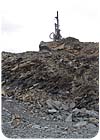
When clearing away waste material that will not be processed, holes are drilled close to one another, and a higher charge - usually dynamite - is used to blast away the stone.
A vast inventory
According to Whitridge, the company has a tremendous inventory of various colors and sizes - essentially 18,000 squares of roofing slate. While that allows the company to be prepared to ship many of the orders that come in, it also provided a challenge for the new owners, who implemented the task of cataloging all of the material in stock and assigning bar codes for each pallet. These bar codes can recall the products' color, length, width, thickness, quarry of origin and whether they have been trimmed and “punched†(a process where the nail holes are punched into the piece).“The bottom line is making sure you can supply what your customers are asking for, and that you can be ready to deliver on short notice,†Whitridge said.
Lead time is three to four weeks for most products that are not in stock, which means Evergreen Slate can accommodate typical projects on a tight schedule, Baker said. The company also produces custom sizes and “cut-butts,†where one end is custom cut on the corners (or rounded) to create a unique aesthetic.

The Calder Quarry site is also home to one of the company's largest mills, and the quarry site has a reclamation pond where the water is recycled and pumped back to the mill to be used during the production process.
The quarries
The company owns several quarries, and it supplies a total of 11 colors of slate from the slate belt, which sits in the Mettowee Valley between New York and Vermont (although most of the quarry sites are actually in Vermont).A new quarry acquisition is a site for Unfading Mottled Green-Purple slate, which is being held by a related company. The site itself was very undeveloped, as it operated on a limited basis for around 20 years before being vacated in the 1970s. “We had to move the old quarry stick and cables, and then do a lot of pumping, blasting and drilling,†Whitridge explained. “It took many months of development to become a quarry. Fortunately for us, the old quarriers missed the best material.â€
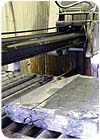
Blocks are cut for length and width size on wet saws, which are fed by conveyor.
At the Unfading Mottled Green-Purple site, approximately 30 feet of waste had to be blasted from the top of the quarry, explained Clark Hicks, who acquired a great deal of quarrying knowledge working in the family business over the past few decades. After clearing the stone, the quarry site will reveal a “slant,†which contains the highest degree of workable material. Generally, these “slants†sit at a 45-degree angle within the quarry; however, the slant at the Unfading Mottled Green-Purple quarry sits at an angle of only 15 degrees, making it much easier to work.

After the slate is cut to size with the saws, the pieces are split by skilled splitters. Using a 3-pound hammer and a 2-inch chisel, these artisans literally evaluate each piece by eye before splitting the material.
Another major quarrying site for Evergreen Slate is its Calder Quarry, which produces two colors - Unfading Green and Unfading Gray. This is one of the company's larger quarry sites, and it has been in operation since the 1950s.
The Calder Quarry site is also home to one of the company's largest mills, and the quarry site has a reclamation pond where the water is recycled and pumped back to the mill to be used during the production process.

After being split, the resulting “chips†are then trimmed to size, a process that also creates a chamfered edge on the pieces. The trimming is done in one of three ways, including the classic manually operated trimmers that have been in use for more than a century as well as powered, hand-fed trimmers.
In the future, the owners of Evergreen Slate plan on “selectively and carefully†acquiring more quarries. Using a backlog of orders, they will determine which colors are the most popular and show the most potential for future sales.
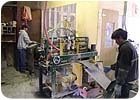
Evergreen Slate also uses automated machinery for trimming slate as well as for punching the nail holes.
The mills
Evergreen Slate operates several processing mills for roofing slate, which serve a variety of functions, including sawing, splitting, trimming and hole-punching. Each mill is equipped with a variety of equipment, depending on the tasks carried out.During the production process, blocks are first split to a size that allows them to fit into the wet saws, explained General Manager Chris Bean. The material then moves onto conveyor saws, which are equipped with wet diamond blades. Pieces are first cut to the desired length and then for width.
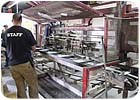
The conveyor lines for hole punching run at three times the speed of traditional methods.
After being split, the resulting “chips†are then trimmed to size, a process that also creates a chamfered edge on the pieces. The trimming is done in one of three ways, including the classic manually operated trimmers that have been in use for more than a century. The mills also operate more modern trimming equipment, including powered, hand-fed trimmers and conveyor-fed trimmers, which have two sets of blades and create finished roofing slate with a tight chamfer.
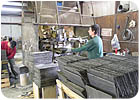
Punches are also created using multi-head drills that are fed by hand.
With the new ownership in place, Evergreen Slate is looking to continue to modernize with new machinery. “We want to keep moving toward automation,†Whitridge said. “We are sensitive to tradition, but at the same time we are looking to modernize and evolve.†Whitridge added that the company will not “abandon†old methods or equipment, though, since certain jobs and products will always require the traditional processing methods.
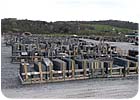
The company has a tremendous inventory of various colors and sizes - essentially 18,000 squares of roofing slate. Recently, the company implemented a bar code system for each palette, which can recall the products' color, length, width, thickness, quarry of origin and whether they have been trimmed and punched.
Sales and marketing
Over the years, Evergreen Slate has supplied slate for projects around the world, including jobs throughout the U.S. as well as markets such as Japan, Indonesia, Australia and Europe. The company sells through wholesale distributors and warehouses as well as directly through contractors. It has sold slate in 49 U.S. states (all except Alaska), and has had strong success throughout the country. “Really, there isn't a region that isn't using slate now,†Baker said. Europe is the second largest market for the company's roofing slate, followed by Canada and then the rest of the world.Over the years, Evergreen Slate has supplied material for some of the country's most prominent landmarks, including the White House and the Pentagon in Washington, DC, as well as dozens of prestigious colleges such as Yale University, the University of Notre Dame, Harvard University, Duke University and the University of Michigan, among others.

The company's storage yard also houses the “flats,†completed products that are ready for shipment.
The size of projects completed by Evergreen Slate can be massive. At the time ofStone World'svisit, for example, the company was working on a golf course/estate project in southwestern Ireland that includes 37 buildings.
But even as the company progresses, it wants to be respectful to its roots and tradition. “This will always be a family-oriented company,†Whitridge said. “We have no intention of saying farewell to the past. We were not just buying the rock, but the people as well.â€
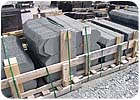
The company also produces custom sizes and “cut-butts,†where one end is custom cut on the corners (or rounded) to create a unique aesthetic.
Jenks echoed these sentiments. “This business is still an art, and it always will be - not only in the production, but in the design and application.â€